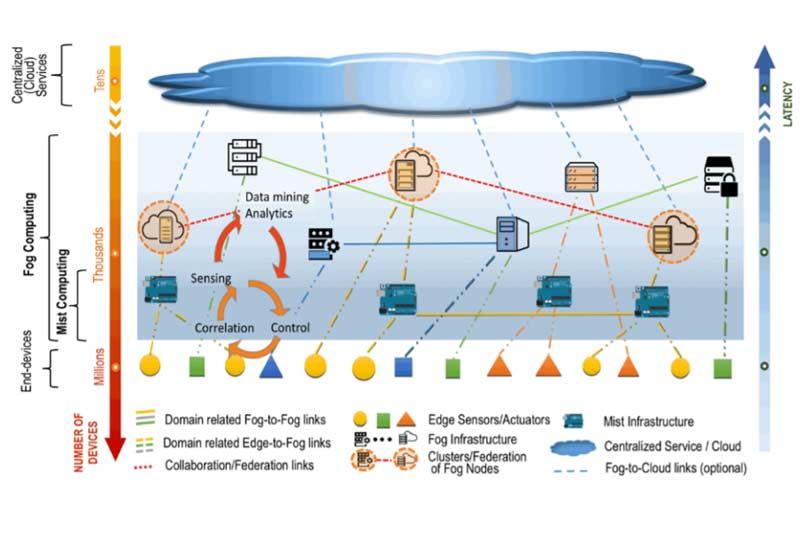
Fog, mist, cloudlets. These meteorological terms are gaining
popularity in the world of computing. They are meant to complement centralised cloud
computing in the context of the Internet-of-Things (IoT).
IoT devices generate unprecedented enormous volumes of data
and it is challenging to transmit all the data back to the cloud for
processing. With increasing need for smart, end-user IoT devices and near-user
edge devices to carry out a substantial amount of data processing with minimal
computing, fog computing offers a way to decentralise applications, management,
and data analytics into the network itself using a distributed and federated
compute model.
At the moment, no consensus exists on distinction among fog
computing, mist computing, cloudlets, or edge computing. A recently
released document
from the U.S. Commerce Department’s National Institute of Standards and
Technology (NIST) strives to provide a definition that can be used by
practitioners and researchers to facilitate meaningful conversations.
The document provides the conceptual model of fog computing
and its subsidiary mist computing, and aims to place these concepts in relation
to cloud computing and edge computing.
The document also lists important aspects of fog computing
and is intended to serve as a means for broad comparisons of fog computing
capabilities, service models and deployment strategies.
Defining fog
computing
Fog computing is defined by NIST as ‘a layered model for
enabling ubiquitous access to a shared continuum of scalable computing
resources’.
According to NIST, fog computing facilitates the deployment
of distributed, latency-aware applications and services, and consists of physical
or virtual fog nodes residing between smart end-devices and centralised cloud
services.
Differentiating between edge and fog computing
The document defines edge computing as the network layer
encompassing the end-devices and their users, to provide, for example, local
computing capability on a sensor, metering or some other devices that are
network-accessible. This is the IoT network itself. While edge computing runs
specific applications in a fixed logic location and provides a direct
transmission service, while fog computing runs applications in a multi-layer
architecture that decouples and meshes the hardware and software functions,
allowing for dynamic reconfigurations for different applications while
performing intelligent computing and transmission services. Moreover, in
addition to computation, and networking, fog computing also addresses storage,
control and data-processing acceleration.
Fog Nodes – the core
component of the fog computing architecture
According to the NIST document, fog nodes are either
physical components such as gateways, switches, routers, servers, etc or
virtual components like virtualized switches, virtual machines, cloudlets [1] etc that are tightly coupled with
the smart end-devices or access networks, and provide computing resources to
these devices.
A fog node is aware of its geographical distribution and
logical location within the context of its cluster. Fog nodes are often
co-located with the smart end-devices, resulting faster analysis and response
to data generated by these devices compared to a centralised cloud service or
data center. They provide some form of data management and communication
services between the network’s edge layer where end-devices reside, and the fog
computing service or the centralised (cloud) computing resources, when needed. The
nodes can operate in centralised or decentralised manner and can be configured
as stand-alone fog nodes that communicate among them to deliver the service. Or
they can be federated to form clusters that provide horizontal scalability over
disperse geolocations.
Fog computing minimises the request-response time from/to
supported applications, and provides, for the end-devices, local computing
resources and, when needed, network connectivity to centralized services.
Six essential
characteristics of fog computing
- Contextual location
awareness, and low latency: Fog computing offers the lowest-possible
latency due to the fog nodes’ awareness of their logical location in the
context of the entire sytems and of the latency costs for communicating with
other nodes. - Geographical
distribution: The services and applications targeted by the fog computing
demand widely, but geographically-identifiable, distributed deployments. An
example would be the delivery of high quality streaming services to moving
vehicles, through proxies and access points geographically positioned along
highways and tracks. - Heterogeneity:
Fog computing supports collection and processing of data of different form
factors acquired through multiple types of network communication capabilities. - Interoperability and
federation: Fog computing components must be able to interoperate, and
services must be federated across domains. - Real-time
interactions: Fog computing applications involve real-time interactions
rather than batch processing. - Scalability and
agility of federated, fog-node clusters: Fog computing is adaptive in
nature, at cluster or cluster-of-clusters level, supporting elastic compute,
resource pooling, data-load changes, and network condition variations.
Similar to cloud computing deployment models, fog node
deployment could be private (for exclusive use by a single organisation
comprising multiple consumers), community (use by a specific community of
consumers from organisations that have shared concerns), public (provisioned
for open use by the general public), hybrid (composition of private, community
or public nodes that remain unique entities, but are bound together).
Mist computing
NIST defines mist computing as a lightweight and rudimentary
form of fog computing that resides at the edge of the network fabric, bringing
the fog computing layer closer to the smart end-devices. Mist computing uses
microcomputers and microcontrollers to feed into fog computing nodes and
potentially onward towards the centralised (cloud) computing services. It is
not a mandatory layer of fog computing.
Read the document here.
[1] According to
Wikipedia, a cloudlet is a mobility-enhanced small-scale cloud datacenter that
is located at the edge of the Internet.
















